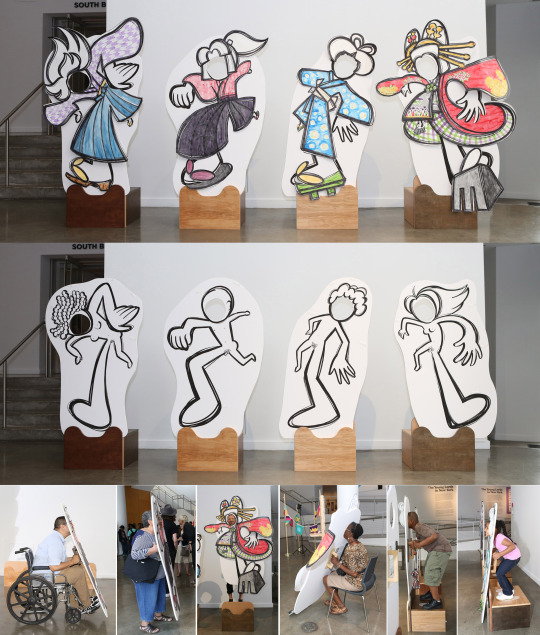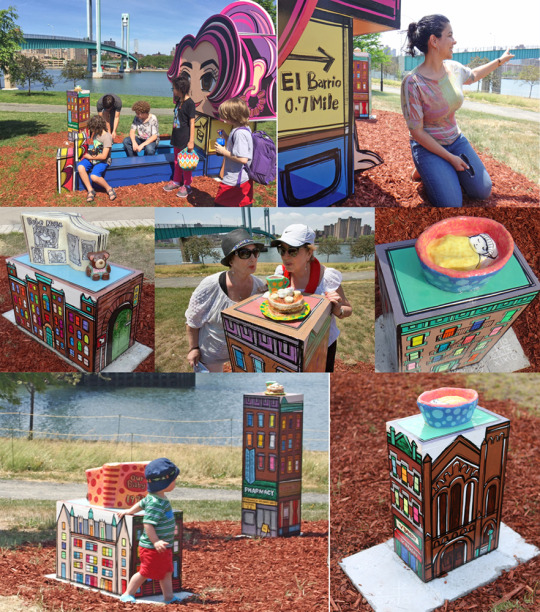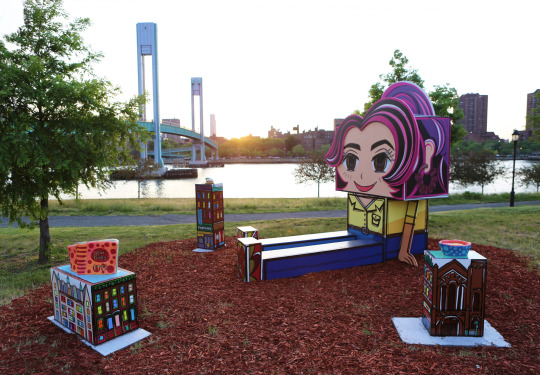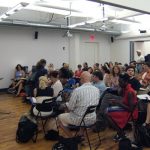RICA TAKASHIMA, ALIENS AND OTHER EXTRATERRESTRIAL BEINGS
I still can’t forget how I thought, “we are like lonely Martians or something, huh.”
Visual Artist Rica Takashima is the recent recipient of a NYFA Opportunity Grant and an alumna of NYFA’s Immigrant Artist Program (IAP). Since moving to the United States from Japan, Takashima has worked tirelessly to share her work with new audiences. In her fiscally sponsored project Aliens in New York Takashima invites participants to gaze at the world through the guise of another. This seemingly transparent idea blossoms into a conduit for social dialogue and personal reflection. She generously joins NYFA Current in conversation, sharing tales of adventure and art making.
Takashima’s work on view at The Bronx Museum of the Arts and FLOW 15 at Randall’s Island through this fall AND you can meet the artist at several upcoming special events!
WHAT: FLOW 15
WHERE: Randall’s Island, on view through November
SPECIAL EVENTS: FLOW Tour, join Rica for a guided tour and stories about her sculptures
WHEN: Thursday, August 13 at 6 PM; Friday, September 4 at 6 PM; Friday November 6 at 4 PM
WHAT: Bronx Calling: Third AIM Biennial
WHERE: The Bronx Museum of the Arts, currently on view through September 20
SPECIAL EVENT: Aliens in New York Workshop at Boogie on the Boulevard: Summer Sundays
WHEN: Sunday, August 16, 12 – 4 PM
LOCATION: Center lanes of the Grand Concourse from 161st Street to 167th Street
NYFA: I love looking at your drawings! From comics to Manga, paintings to installations, drawing is fundamental to your work. When did you begin drawing? Who encouraged you to pursue art?
Rica Takashima: In Tokyo, where I was born and grew up, there have always been many bookstores, all with dedicated manga sections carrying monthly and weekly magazines as well as graphic novels. It was and still is customary for elementary and middle school children to stop by bookstores after school and read or buy manga before heading home.
There also were always one or two kids in each class who’d make their own original manga and pass them around to their classmates. Plus, many hours of anime were available to be watched on TV every day, as well.
I come from a family of traditional Japanese calligraphy artists who, for generations, earned a living by teaching children. I myself took lessons from when I was three, but I preferred doodling manga images using the calligraphy brushes and ink instead of practicing.
I also made flip-manga on the page corners of my textbooks. When I entered high school and started learning technical drawing and design skills, I had fun penciling in hyper-dramatic shadows and dialogue to captioned photos of people in my history books.
In short, what I want to say is that there are many people in Japan who encounter or experience art through manga and anime, and that I, too, became an artist through such contact.
NYFA: Your project Aliens in New York is fiscally sponsored by NYFA and the title is inspired by your status as an “alien” at JFK airport when you immigrated in 2008. How has your relationship with New York changed since this time? How does your role as an immigrant influence your observations of American culture?
RT: When I landed at JFK International Airport with my family, we spoke much less English than we do now. And my daughter needed my close attention because she was not even grade school age at the time. Thus, when I was called an alien, I didn’t understand why at first and was shocked. I still can’t forget how I thought, “we are like lonely Martians or something, huh.”
Back then, I wondered if Americans saw immigrants as extraterrestrial beings. But as time went by, I started to understand that immigrants were only one type of people considered in such a way. Others include LGBTQ individuals, the visually impaired, and people in wheelchairs; perhaps every single one of us treats certain others as aliens. Someone who keeps secrets in isolation from his or her family and friends may be an alien as well.
Perhaps the phrase “immigrants are aliens” has led to the word “alien” getting increased attention in general. Or maybe I am more sensitive to this viewpoint because my family and I felt alone when we first arrived in America.
I believe it was at the 2013 Women in Comics Con where I was exhibiting Aliens in New York, that I learned that female artists in the American superhero comics industry habitually use male or non-gender-specific pseudonyms so that their gender would not be obvious. One creator even told me she didn’t have the courage to freely illustrate a story personal to her, despite drawing superheroes.
As an artist, I would like to continue focusing closely on those whose existence has been abandoned or gone unnoticed in the world. I want to keep drawing them because I think it is magnificent when they stand up and overcome adversity or change society.

NYFA: You refer to the freestanding cut-out sculptures you create as Peekaboo-kun. Their illustrated faces can be removed, creating a hole through which participants can poke their faces, view the world and embody a new character. How did you begin making Peekaboo-kun? In what ways do you think they induce transformation in your audience?
RT: At art college, my major was traditional Japanese decorative art, but I also participated in my school’s theater club on the side. I passionately worked on set production backstage. It was then that I first conceived and executed the idea that it might be fun to paint my manga-style drawings on the thin plywood boards used for stage sets and display them on city streets.
That was 1994, when Peekaboo-kun was born. My first project was titled Make Your Ideal Family, where participants were asked to choose Peekaboo-kun pieces to represent members of a family cluster they considered ideal. This took place in Harajuku, Tokyo, which at the time was instituting temporary street closures on weekends for the benefit of pedestrians, resulting in the birth of a center of youth culture with young people gathering to play music and dance. This is why I selected it for my project site. It was very similar to how the East Village or Union Square areas still are in New York.
Peekaboo-kun are very noticeable because they are heavily influenced by Japanese manga and anime culture. Such an unthreatening drawing style is also useful in enticing both shy children and wary adults to step forward and interact with the boards of their own accord.
What is also important is to strive to create a fun environment where the maximum number of people can relax and feel free to be daring and without prejudice. It is helpful to utilize locations people are already accustomed to using or that are convenient, places with resting spots, eateries, and/or things to see other than just my exhibition, such as music and dance events. Such spaces remove participants’ tension and allow them to enjoy taking part.
So far, the themes of my exhibitions have included family, marriage, gender and bullying. Even though they are serious topics, participants have been able to have fun plus consider things they’ve never thought about or put themselves in someone else’s shoes due to the comforting atmosphere I’ve produced.
In addition, there is a label pasted on the back of each Peekaboo-kun describing that character’s life story. This is so that a participant can have a better understanding of and empathize with that character’s psyche before placing their face out the hole in the board.
Currently about 100 Peekaboo-kun exist, and each time I put on Aliens in New York, I select which of them I’ll exhibit depending on the theme or locale of the show, sometimes creating new ones as well. For example, I asked a Bronx resident to model for a new Peekaboo-kun that I have then used for my current exhibit at the Bronx Museum of the Arts, so that visitors from the neighborhood can relate more to my art.
Its label reads as follows:
Mx. Grant: I live in Castle Hill, the Bronx. My grandparents came from South Carolina to New York City and eventually settled down in the Bronx. They had several children, including my mother! I was born in Fordham Hill. Eventually my mother and I moved in with my grandmother in Castle Hill. My family is here. My friends are all over New York City. The Bronx is beautiful. That’s why I live here.
When I eat something delicious, I do the happy dance!
NYFA: The bright colors you use in Aliens of New York pull my gaze to your work. Upon a closer look, I am forced to reflect upon my own inherent cultural and racial biases, as many of the characters are depicted as stereotypes. I quickly transition from feeling very comfortable to uncertain about my role as viewer. Creating an environment that nurtures this sort of transformative experience can be challenging. What sorts of reactions to Aliens of New York have you received from viewers and participants?
RT: The first American community I was influenced by when I immigrated to New York with my family in 2008 was PS122Q, the elementary school my then seven-year-old daughter attended. Many of its students are non-English-speaking immigrant children who have just arrived from one of over 40 different countries. They were dropped off and picked up every day by parents or guardians wearing traditional garments. It was very bright and colorful, and I feel it heavily influenced early iterations of Aliens in New York.
I was also moved by the stories of families that due to various circumstances had come to the United States to start new lives. For example, I have watched families from Tibet and China, or North and South Korea, perform folk dances together on the same stage wearing traditional outfits. Those who did not own any, danced wrapped in the flag of their birth nation. That they could respect each other and have pride in donning their native dress, made a deep impression on me. The Peekaboo-kuns that wear traditional costumes represent my admiration of them. I wanted my Peekaboo-kun to become symbols of intercultural acknowledgment and acceptance, by having people of various backgrounds place their faces out the holes of Peekaboo-kun wearing native dress of a country other than their own.
I used these costumed Peekaboo-kun for my 2013 and 2014 Aliens in New York exhibits in Astoria and Jackson Heights. My exhibit was received very well. Several people even asked me if they could be models for new Peekaboo-kun so that others can be educated about their particular cultural background.
I was also often asked, “I’m sad that Aliens in New York is only on today. I want to come back with my friends and family. Where will you be doing this next?” On the other hand, I am sure there are others who participate because it’s fun to do so, but aren’t interested in the concept itself. But I believe that the latter will eventually come to value their experience over time.
An interesting conversation occurred when I was looking into crafting special pedestals so that it would be easier for wheelchair-bound and other physically challenged people to partake in Peekaboo-kun. A mother who I was consulting with, whose two children are severely disabled, said to me, “I would really like wheelchair-bound people especially to participate in this kind of art.” She told me that there are some children confined to wheelchairs who cannot imagine what it would be like to be free of their physical disabilities and be as if they were someone else.

NYFA: How do you choose exhibition venues and sites for Aliens in New York?
RT: When I first started out in 1994 in Japan, I chose areas of Tokyo with pedestrian-only streets since they experienced heavy foot traffic to begin with in addition to being popular sightseeing spots that drew many domestic and international tourists, also because I was able to regularly put on exhibitions there.
Regarding future exhibition sites, there are three points that must be considered:
The first is the safety of the participants and my staff. There was an incident at a one-day outdoor exhibition in 2014, when a sudden thunderstorm forced me to cut the show to only 30 minutes, and several Peekaboo-kun were blown away by strong winds and ended up heavily damaged. Fortunately, no person was injured, but, figuratively, it was a very painful experience. It taught me the necessity of ensuring the safety of both participants and my staff. And not just in terms of weather, but selecting locations with minimal risk of assault or violence from others as well, where visitors can partake freely and naturally without fear or prejudice.
Second, a figuratively open, non-restrictive space is necessary. New York attracts not only immigrants, but also many domestic and international tourists. It is a place where people behave freely and feel liberated to do things they would never even imagine doing back in their former country or hometown. I want to harness that thrill that people get sightseeing to encourage them to explore and participate in Aliens in New York, which to some might seem taboo under normal circumstances, and take pictures with Peekaboo-kun in a casual way similar to how they would snap photos with a Mickey Mouse impersonator in Times Square.
The third is actually the complete opposite of the second, the need for a private space. I learned from my exhibits in Astoria and Jackson Heights that some people feel embarrassed and are uncomfortable participating if their family or close friends are around or are outright unable to partake because it is taboo. One Syrian woman told me that she wished to have her picture taken with one of the Peekaboo-kun, but couldn’t because she was with her husband. She also told me that she would like to be a model for a Peekaboo-kun, but wanted it kept secret from her husband, and also asked me to use a pseudonym instead of her real name for the character when the piece was to be exhibited. What that led me to consider is setting up a space and time for a single person to enjoy the piece(s) in absolute freedom. I have never put on such an exhibition yet, but I’d like to keep it in mind for the future.
These three points may not always be able to be executed together. What is interesting about Peekaboo-kun is that while all one has to do is stick one’s own face in the hole cut out where the character’s face would be, one’s impression of the piece can differ greatly depending on the environment where the piece is being exhibited, the timing of one’s participation, or even the visitor him- or herself.
During my 2014 exhibition in Jackson Heights, some residents became violent and threw or kicked various objects on the streets, perhaps due to the outcomes of World Cup soccer games going on at the time, and I was worried Peekaboo-kun characters representing countries those people did not care for would get vandalized. I want participants to interact with Peekaboo-kun without assumptions or biases, rather than have the pieces cause or incite emotions.
From all these experiences, I have come to think that good sites for my exhibitions are places where participants can interact with my pieces safely and desire to come back over and over. For example, one possibility is limited-time installations at public parks, public libraries, or other public spaces like the Staten Island Ferry terminal. Another is exhibiting at famous sightseeing spots such as the main concourse of Grand Central Terminal or the promenade at Rockefeller Center. Other exhibition spaces where one could view Peekaboo-kun effortlessly and without bias include the vestibule of the Museum of the City of New York and the Metropolitan Museum of Art’s Great Hall.
I do not yet have any concrete ideas regarding sites where private exhibitions could take place, but since Aliens in New York has always involved taking instant photos of visitors to craft Certificates of Participation, not creating such records would likely have to be one requisite of such an exhibition.
NYFA: Congratulations on your exhibition of El Barrio Comes in All Colors, Shapes and Sizes at FLOW 15 on Randall’s Island. Inspired by your own exploration of East Harlem, the work explores life in the El Barrio neighborhood and includes a female figure who sits nearly eight feet tall and surrounding smaller buildings. How is El Barrio Comes in All Colors, Shapes and Sizes influenced by Aliens of New York?
RT: As an artist, I feel empathy towards people whose existence is ignored or overlooked by society. For instance, I once read in documentary books that Puerto Ricans were a disregarded population up until around 1970, not receiving basic services typically guaranteed to city residents such as trash collection and vaccination of young children.
However, Puerto Ricans made the neighborhoods they inhabited more livable, by changing the social welfare system in New York City. One Puerto Rican woman who was born and raised in East Harlem watching this movement has as an adult opened a café there which provides a new relaxing spot in town. What I wanted to convey through this project is that even an alien or solitary existence possesses the capability to one day actively engage with and improve society. Such movements are not very conspicuous in the land where I was born and grew up, Japan. Thus, I suspect that this is one of the great strengths of New York, or even America as a whole.
In El Barrio, I took what I learned about East Harlem, Puerto Rican culture, as well as 1970s history, none of which I had previously known, and merged it with my manga style art. It was my first attempt to create three-dimensional sculptures using my art expression, and I gained a lot from this challenge. I encourage everyone to come to the exhibit, sit on the bench formed from my sculpture figure’s legs, and enjoy the view of East Harlem.

NYFA: Why did you choose to apply for NYFA fiscal sponsorship?
RT: The reason I applied for NYFA fiscal sponsorship is that I wanted to get recognized and become trusted by American society. My family, including me, is made up entirely of immigrants who don’t speak English, have stable jobs, are not accustomed to American culture and don’t know anyone in the art community. I never attended college nor received any formal education in the United States. I was a completely nameless, powerless individual.
I feel as if I do not yet grasp many things about the United States. I’d like to keep learning and working hard while receiving advice regarding future possibilities and opportunities.
NYFA: In 2013 you were a mentee in the Immigrant Artist Mentoring Program (IAP) at NYFA. You gained one-on-one support navigating NYC’s cultural landscape with artist mentor Carlos Martinez. What did you learn through participation in the program and what connections continue beyond it?
Up until that point, I hadn’t been part of any artistic communities in America, much less New York, so NYFA fiscal sponsorship and IAP were my first encounters with the New York art world.
Carlos is an immigrant artist himself, so he understands the challenges I’ve faced as well as questions I have about the New York art scene and was able to give me pertinent, valuable advice.
If he had been an American-born and raised artist, he might not have fully comprehended my hardships and problems. It was through his recommendation that I was able to exhibit Aliens in New York in Jackson Heights in 2013 and 2014.
I am truly grateful to NYFA for pairing me up with Carlos through their mentoring program.
Don’t forget to like Aliens in New York on Facebook and view the project’s fiscal sponsorship page for more amazing photos and to make a tax-deductible donation!
Are you seeking a fiscal sponsor for your project or emerging organization? Click here to learn more! You can also learn more about the Immigrant Artist Program (IAP) by clicking here.
Translation assistance provided by Mari Morimoto
– Interview conducted by Madeleine Cutrona, Program Assistant, NYFA Fiscal Sponsorship
Images, from top: Rica Takashima, Peekaboo-Kun, Photo credit Phil Ginley; Photo credit Phil Ginley; Photo by Eryn Hatzithomas: left in the middle row (album and bear), Photo by Marc Gersh: middle in the middle row (two women), Photo by Maria Tolios: right in the bottom row (baby building); Photo by Maria Tolios





